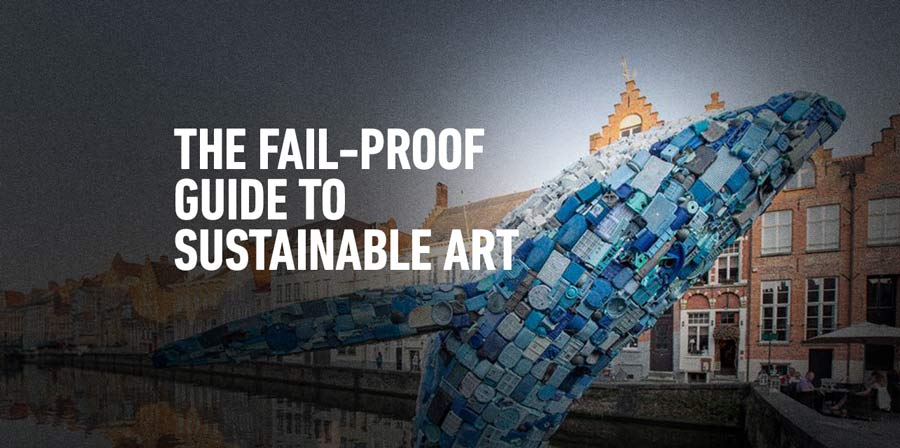In a world overwhelmed by constant change and fleeting trends, one movement stands out, highlighting the beauty found in preserving our planet: sustainable art. This guide will take you through the captivating world of sustainable art, exploring its meaning, significance, and impact on society. Get ready for an exciting journey filled with vibrant eco-conscious materials, innovative methods, and visionary artists who are making a difference, one brushstroke at a time.
Grasping the Concept of Sustainable Art
Before delving into the fascinating world of sustainable art, let’s first clarify its essence. Sustainable art is created using environmentally friendly materials and techniques, promoting the value of sustainability. It’s a form of artistic expression that harmonizes creativity with environmental stewardship, like nature’s own art exhibit, celebrating the delicate balance between artistic innovation and conservation.
The Essence of Sustainable Art
Imagine a world where art and sustainability blend into a seamless expression of color, form, and meaning. Sustainable art aims to unite human creativity with ecological responsibility. It encourages artists to go beyond traditional mediums, using their art to raise awareness about important environmental issues.
When we think of sustainable art, we’re often reminded of the awe-inspiring beauty of the natural world. Artists who champion this movement frequently draw inspiration from nature, weaving a sense of wonder and respect for the environment into their creations. These pieces serve as visual tributes to the fragile beauty of our planet, urging us all to play a role in its preservation.
Consider, for example, a sculpture made from entirely recycled materials. The artist carefully selects discarded items and transforms them into a stunning piece of art, giving new life to what was once considered waste. This not only showcases the artist’s creativity but also emphasizes the potential for repurposing and reducing waste in our own lives.
Why Sustainability Matters in Art
Art has an undeniable power to captivate and inspire. By weaving sustainability into their works, artists don’t just create beautiful pieces—they also make a meaningful impact on the world. Sustainable art serves as a catalyst for change, sparking conversations about our relationship with the environment.
Through the lens of sustainable art, we gain a fresh perspective on the environmental challenges we face. It serves as a reminder that we all have a part to play in crafting a sustainable future. It prompts us to reevaluate our consumer habits, reflect on the life cycle of the products we use, and seek creative ways to lessen our environmental impact.
Imagine stepping into an art gallery, greeted by paintings that depict the effects of climate change. Each stroke tells a story of melting glaciers, vanishing species, and the urgency for action. Standing before these artworks, you can’t help but feel a call to responsibility and change.
But sustainable art doesn’t stop at traditional mediums like painting and sculpture. It spans performance art, installations, and even fashion. For instance, sustainable fashion designers use organic and recycled materials to craft their designs, challenging the fast fashion industry and promoting ethical practices.
So, whether you’re an art lover or someone passionate about the planet’s future, sustainable art provides a refreshing and insightful experience. It encourages us to appreciate the natural world’s beauty while motivating us to act and make a real difference. Sustainable art is more than just visual appeal; it’s about harnessing creativity to drive positive change.
The Fusion of Art and Sustainability
Now that we’ve delved into the core of sustainable art, let’s examine how it connects with the wider conversation around sustainability. Art has always mirrored society’s concerns, and as environmental issues rise to the forefront, artists have embraced the role of environmental advocates, using their creativity to make a positive impact.
How Art Speaks to Environmental Issues
Artists have a remarkable ability to turn complex ideas into visually compelling pieces. Through their art, they give form to our most pressing environmental concerns, making them more accessible and relatable. Consider artworks that illustrate the effects of deforestation or the consequences of pollution on marine ecosystems. These pieces stand as powerful reminders of the critical need to protect our planet.
From awe-inspiring murals on public buildings to thought-provoking installations in art spaces, art has the ability to stir emotions and motivate action. It urges us to reconsider our consumption habits, promote sustainable practices, and safeguard the environment for future generations.
The Role of Artists in Advancing Sustainability
Artists play a pivotal role in driving change, using their creative voices for good. They challenge conventions, break barriers, and ignite discussions about sustainability. By integrating eco-friendly materials and sustainable techniques into their art, they are laying the foundation for a more environmentally conscious future.
Through their creations, artists inspire others to view the world from a different perspective. They challenge us to reflect on our choices and consider the environmental impact of our actions. Sustainable art has the power to awaken a sense of responsibility in us all, sparking a passion for positive change and supporting a global movement towards a more sustainable society.
Materials and Methods in Sustainable Art
Now that we’ve discussed the philosophical aspects of sustainable art, let’s dive into the practical side—examining the materials and techniques artists use to bring their environmentally conscious creations to life.
Eco-Friendly Art Supplies
The days of relying on traditional materials that harm the environment are long gone. Today, a wide array of sustainable art materials is available, waiting to be explored. From recycled paper and plant-based paints to reclaimed wood and biodegradable sculptures, eco-friendly materials are now at the forefront of artistic creation.
Artists are embracing the potential of natural and recycled resources to craft stunning pieces that are not only visually striking but also reflect their dedication to sustainability. By blending innovation with artistic expression, they breathe new life into discarded items, reducing waste and turning them into valuable works of art.
Cutting-Edge Techniques in Sustainable Art
Artists are known for their resourcefulness, constantly pushing the limits of their creativity. In the world of sustainable art, they’re leading the charge with inventive methods that break from tradition. Whether it’s using solar power to run their studios or experimenting with unusual mediums, their ingenuity knows no bounds.
One technique that has gained popularity is “upcycling”—the art of transforming unwanted materials into something of greater value. Artists take discarded objects and turn them into mesmerizing pieces, challenging our ideas about waste. This process highlights the power of creativity and resourcefulness in making something beautiful and meaningful from what would otherwise be discarded.
The Influence of Sustainable Art on Society
Art has long been a catalyst for societal transformation, and sustainable art continues this tradition. Let’s take a look at how it shapes public perception and plays a crucial role in education.
Shaping Public Perception Through Art
Sustainable art speaks a universal language, crossing cultural and linguistic boundaries. It has the ability to engage audiences, evoke strong emotions, and inspire change within society. When powerful art captures the public’s attention, it can shift perspectives and encourage positive action.
Whether it’s an awe-inspiring mural motivating urban residents to adopt sustainable habits or a thought-provoking exhibit highlighting the effects of climate change, sustainable art has the potential to unite communities and rally support for environmental causes.
The Role of Sustainable Art in Education
Education is the foundation of progress, and sustainable art has carved out a unique space in classrooms worldwide. It acts as an impactful educational tool, encouraging students to explore the connection between art and sustainability while nurturing critical thinking skills.
Through hands-on projects and workshops, sustainable art enables students to voice their concerns about environmental issues. It empowers them to become advocates for change, teaching them the significance of sustainability while also helping them unlock their creative potential.
The Future of Sustainable Art
As the world faces increasing environmental challenges, sustainable art is set to play an even more pivotal role in shaping our future. Let’s take a glimpse into what lies ahead.
The Rise of Sustainable Art
Sustainable art is rapidly gaining ground in the art world, spreading like an eco-conscious wildfire. More galleries and museums are now dedicating spaces to feature works that prioritize environmental awareness. Collectors and art lovers alike are becoming more selective, searching for pieces that not only resonate with their aesthetic tastes but also reflect their core values.
This growing interest in sustainable art is a reflection of society’s shifting mindset, as an increasing number of individuals recognize the critical importance of sustainability in all aspects of life, including the arts.
Anticipated Advancements in Sustainable Art
The field of sustainable art is evolving swiftly, constantly pushing the boundaries of what’s possible in terms of creativity and innovation. With technological advancements on the horizon, we can expect to see the blending of sustainability and digital art, where virtual experiences will highlight ecological issues and spur action.
Technologies like 3D printing, augmented reality, and virtual reality hold the potential to transform how we create and engage with sustainable art. These tools will offer artists new ways to deliver powerful messages and immerse audiences in stunning, interactive experiences.
The future of sustainable art is an open canvas—an exciting opportunity for both artists and enthusiasts to help build a more sustainable and vibrant world.
In conclusion, we’ve taken an inspiring journey through the world of sustainable art—from its concept and significance to the materials and techniques artists employ, and its profound impact on society. Sustainable art is a transformative force for change.
As we continue our collective efforts to protect the planet, let’s remember that there is beauty in these shared endeavors. Sustainable art reminds us that we possess both the creativity and the responsibility to create a more sustainable future, one brushstroke at a time.










